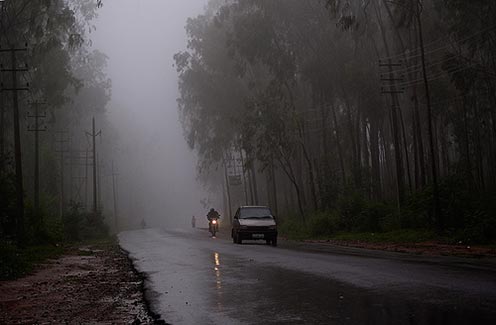
South-west monsoon has active over Kerala. Rain occurred at most places in Lakshadweep.
The rains, and relief, are on their way
and would shower their blessings on the scorched state by next week,
“The wind direction has changed from westerly to easterly in
sub-Himalayan Bengal from the day before yesterday (Tuesday). This has
sped up the flow of the eastern wing of the southwest monsoon towards
north Bihar. It has already covered the entire sub-Himalayan Bengal. As a
result of this, advancement of monsoon thunderstorms, accompanied by
rainfall, has been observed in the northern parts of the state.”
He added: “On the basis of the prevailing conditions, we expect that monsoon would enter north Bihar between June 13 and 15.”

Sea surface skin temperature anomalies in November 2007 showing La Niña conditions
The extremes of this climate pattern's oscillations, El Niño and La Niña, cause extreme weather (such as floods and droughts) in many regions of the world. Developing countries dependent upon agriculture and fishing, particularly those bordering the Pacific Ocean, are the most affected. In popular usage, the El Niño-Southern Oscillation is often called just "El Niño". El Niño is Spanish for "the little boy" and refers to the Christ child, because periodic warming in the Pacific near South America is usually noticed around Christmas.This year El nino is weak so chances of Monsoon will come very soon
Last year, monsoon had entered the state on June 15.
Abdul Sattar, assistant professor of
meteorology, Rajendra Agriculture University, Pusa, echoed the Met
department’s observation. “Monsoon is progressing at a very high speed
in sub-Himalayan Bengal. It is expected that monsoon would enter the
northeastern region of Bihar in four to seven days. Going by the present
calculations, Kishanganj would be the first district to be hit by the
monsoon.”
Sattar claimed that favourable dynamics in
weather conditions over the Bay of Bengal and in the sub-Himalayan
region on the mainland have led to speeding up of monsoon in the region.
Earlier, weather scientists had claimed
that the arrival of monsoon in Bihar was likely to be delayed by five
days from the normal date of arrival due to rise of 0.5°C in the surface
temperature of the Pacific Ocean.
No comments:
Post a Comment